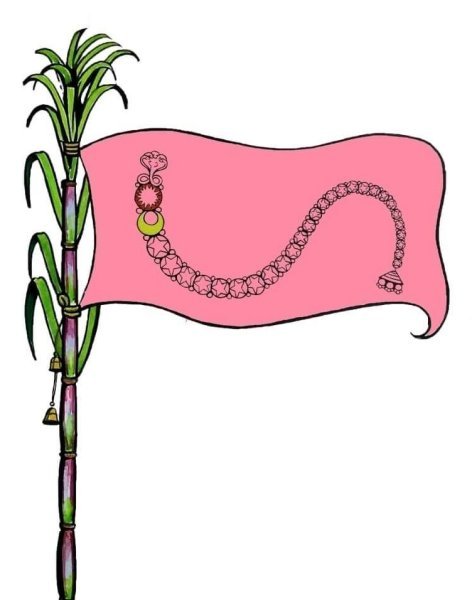Snippets of Information
Dance - Kuchipudi
* 11 Jan 2025

The year 2024 marked the 50th anniversary of the Kuchipudi flag, created by the hereditary Kuchipudi Guru Vedantam Parvateesam in 1974, who was inspired by Pingali Venkayya, the creator of India's national flag.
This flag has a highly spiritual and metaphysical significance. The
sugar cane stalk used as the flagpole represents the physical
manifestation of the ‘manas’ or heart, where all art is born. This is
inspired by the 10th ‘Naamam’ in Lalitha Sahasranamam - ‘Mano Rupekshu
Kodanda’.
This sugar cane stalk has 10 nodes, which represent the ten ‘Avasthas’
or desires of a human being described in the Natya Sastra. The leaves
above the sugar cane stalk represent the ‘Sanchaari Bhavas’, the
emotions that contribute to Rasa. The pink ‘Arunodaya’ colour of the
flag represents ‘Chaitanya’, the inner consciousness, because the art
awakens our inner consciousness. Satyabhama's braid has been placed in
the centre of the flag, representing the essence of the identity of the
Kuchipudi art form. The entire universe is shown in this braid,
including Sri Vishnu's Aadi Sesha, the Sun and Moon, the nine planets,
the twenty-seven constellations of stars, and the three worlds.
As a tribute to the 50th anniversary of this flag and Guru Vedantam
Parvateesam's great contribution to the Kuchipudi art form, the
Kuchipudi Heritage Arts Society organised a three-day festival in the
Kuchipudi village in Andhra Pradesh, in December 2024. A 50-foot
stupa was constructed for this festival, where the Kuchipudi flag was
hoisted on this historical occasion.
Source: 50 years celebration of the ‘Kuchipudi Flag’ at the Indian Embassy, Washington by Manjari Sinha, narthaki.com, 11 Jan 2025
* 13 Nov 2022
Kuchipudi is the classical dance form from the state of Andhra
Pradesh. It derives its name from the village of Kuchelapuram, a
small village about 65 kms from Vijaywada. It is known for its
graceful movements and its strong narrative / dramatic character.
Siddhendra Yogi settled in the village of Kuchelapuram and
started teaching Brahmin boys in devotional dance dramas based upon
religious themes which were presented as offerings to God in the
tradition of the Natya Shastra.
Tana Shah in 1678 granted the lands around Kuchipudi to the Brahmins who performed the dance.
Source: chandrakantha.com
Siddhendra Yogi first developed a unique and particular style based on
the Natyashastra, Bharatarnava and Nandikeshwara's Abhinaya Darpana.
However, Siddhendra Yogi confined the practice of the dance form to only
male Brahmins, by training them, and thereby giving the dance the
sanctity of the fifth Veda. As such, even female roles were played by
men. Siddhendra Yogi is also credited with the composition of many
kalapams (dance dramas) and one of them is the famous Bhama Kalapam
(story of Sathyabhama, Krishna’s wife).
Source: Kuchipudi, An Overview by Dr Veena Murthy Vijay, sahapedia.org, 29 May 2020
* 13 Nov 2022
The dance traditions of Andhra are divided into two distinct styles - the Nattuva Mela and the Natya Mela.
Nattuva Mela is a solo dance performed by women, and the nattuvangam
(cymbals played for rhythmic support) is generally played by men. The
repertoire of this style of dance consists of both Sringara (erotic) and
Bhakti (devotional) items. This is the form of dance that both the
temple dancers and the court dancers practised and performed with gods
or kings as the hero of the theme of their dances, as the case may be.
The second style of dance, Natya Mela is generally performed by both men
and women. The repertoire consists of dance dramas with themes, not
necessarily religious, to entertain the audience and also to update the
community with the policies of the provincial kings, known as samantha.
This latter form of dance is believed to be the forerunner of
present-day Kuchipudi dance.
Source: Kuchipudi, An Overview by Dr Veena Murthy Vijay, sahapedia.org, 29 May 2020
|